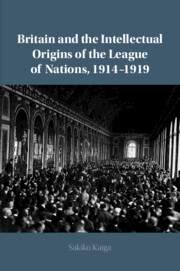Book contents
- Britain and the Intellectual Origins of the League of Nations, 1914–1919
- Britain and the Intellectual Origins of the League of Nations, 1914–1919
- Copyright page
- Contents
- Acknowledgements
- Abbreviations
- Introduction
- 1 Precursors
- 2 The Use of Force to Prevent War?
- 3 Strategies for Winning Public Opinion
- 4 A Transnational Movement?
- 5 No Peace without Victory
- Conclusion
- Appendix
- Bibliography
- Index
3 - Strategies for Winning Public Opinion
The Success and the Loss of the League of Nations Society, 1915–1917
Published online by Cambridge University Press: 27 April 2021
- Britain and the Intellectual Origins of the League of Nations, 1914–1919
- Britain and the Intellectual Origins of the League of Nations, 1914–1919
- Copyright page
- Contents
- Acknowledgements
- Abbreviations
- Introduction
- 1 Precursors
- 2 The Use of Force to Prevent War?
- 3 Strategies for Winning Public Opinion
- 4 A Transnational Movement?
- 5 No Peace without Victory
- Conclusion
- Appendix
- Bibliography
- Index
Summary
Building on the Bryce Group’s post-war plan, the League of Nations Society was founded in 1915 to promote a peaceful organisation to the public. After the Society’s first public meeting in May 1917, the pro-league movement successfully evolved from a small circle to a mass movement that mobilised the public to establish a league. Previous studies have, therefore, regarded May 1917 as a positive turning point of the movement and mainly focused on widespread support for the league thereafter. Yet, the year 1917 also marked the time when the originators of the movement began to lose control of defining what the league would be like. To communicate to the general public, the Society simplified its ideas by underscoring only the creation of an international organisation without going into details. It led the movement to abandon its original, sophisticated discussions about a new order, which became accelerated in the following years.
Keywords
- Type
- Chapter
- Information
- Publisher: Cambridge University PressPrint publication year: 2021

